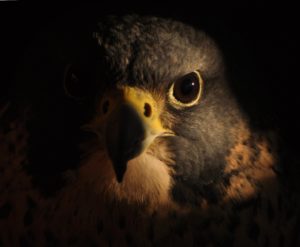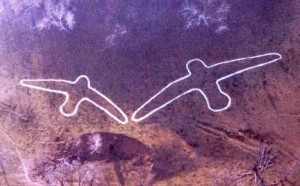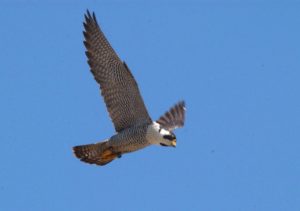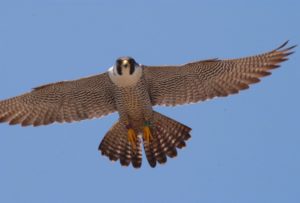Photography courtesy of Lowell Washburn, all rights reserved.
It’s late July, and I’ve arrived at my destination just in time to see the sun rise above the Mississippi River. I’m perched atop the towering wall of a 350-foot, limestone cliff face overlooking the river. Needless to say, the view is spectacular as the eastern horizon explodes into brilliant hues of orange and gold. Although getting here required a three hour, wee-hours-of-the-night drive and a twenty minute hike through dense woodlands, the trip has already been well worth the effort — and then some.
But as magnificently beautiful as the scene may be, viewing the sunrise is not the reason for my visit. Instead, I have traveled here hoping to obtain a fleeting glimpse of peregrine falcons. With dives exceeding 250 mph, the peregrine is credited with being the planet’s fastest bird. Following decades of absence, the legendary “duck hawk” is currently staging a comeback along the historic cliff ledge habitats of the Upper Mississippi. Expectations are high. During recent visits to the Big River, I’ve managed to see falcons on each and every trip. Without fail, each sighting has provided a new and unique outdoor adventure.
Peregrine watching is nothing new to the Mississippi. It is a tradition almost as old as the river itself. Stone age human admirers left behind tangible records in the form of earthen [effigy] mounds. Archeologists say that the oldest of these mounds were constructed nearly 1500 years ago; fashioned by unnamed and long vanished indigenous cultures. The effigies illustrate many life forms including bears, salamanders, and eagles. But it is the peregrine effigies that intrigue me most. Two of the most spectacular examples are located in extreme northeast Iowa. Depicting a pair of falcons engaged in aerial courtship, the effigies spark the imagination and are as huge as they are incredible. The largest of the pair — a female — measures an amazing 283 feet, wing tip to wing tip.
Several years ago, the mounds’ outlines were traced in lime and then photographed from the air. While viewing the results, I mentioned to the landowner that the birds appeared to be “true to scale” with the male falcon being about a third smaller than female. Grabbing a measure, we quickly determined that the peregrine effigies were indeed perfect. Considering that the ancient builders had to transport material to the site one basketful at a time, the effigies offer profound testimony to the level of esteem these prehistoric hunters had fitfully bestowed upon the river’s supreme winged predator.
Historically, the rugged blufflands of the Upper Mississippi provided a population stronghold for mid-continent peregrines. Long after the mound building cultures had vanished, humans and peregrines continued to coexist in relative harmony. Even when European settlement had driven elk, bison, whooping cranes, swans and a host of other species from the landscape, peregrine falcons continued to thrive; a species seemingly unaffected by the relentless advance of civilization.
But the harmony ended abruptly as the post-World War II use of DDT pesticides began to exact its deadly toll. Toxins accumulated. Egg shells thinned. Reproduction failed. By the early 1960s, peregrine populations were in free fall and the species would be completely eradicated from the Upper Mississippi by the close of the decade.
The last known peregrine eyrie was located on a cliff near Lansing — just a bit upstream from where I’m sitting. Following a series of failed nesting attempts, both adults eventually vanished. After that, no peregrine falcons — not so much as a single bird — could be found anywhere from the Mississippi to the Atlantic. For mid-continent peregrine falcons, the horrific prophecies portrayed in Rachel Carson’s Silent Spring had become a stark reality. In the figurative blink of an eye, the long esteemed aerial hunters were gone.
But times change — sometimes for the better. Following a decade of bitter debate, the use of DDT was forever banned [in the U.S.] in 1972. Meanwhile, at New York’s Cornell University, a tiny cadre of American falconers were attempting to breed peregrine falcons in captivity. The experiment succeeded and falconers from across the globe were soon donating their precious hunting birds to the project. Through the release of captive produced babies, endangered peregrines soon began the long road to recovery.
Today, a generation of New Age peregrines are accepting the synthetic cliff nesting habitats of big city skyscrapers, urban bridges, and power plant smokestacks. Best of all, nesting falcons are also returning to the historic cliff ledge sanctuaries of the Upper Mississippi. Iowa was the only state to successfully release captive produced fledglings into wild Mississippi river habitats. As the direct result of a cooperative three year [1998- 2000] joint venture between the Iowa DNR, nongovernmental organizations [including the Iowa Wildlife Federation], University of Dubuque Environmental Sciences students and Iowa falconers; a total of 77 fledgling peregrine falcons were released on the Mississippi.
Free flying descendants of those captive bred peregrines continue to grow in number. During 2014, a total of 17 active nesting territories were documented in Iowa — an increase of two territories over the last year. [During 2013, a total of 15 nesting territories produced 31 young.] Although surveys are not complete, similar production is expected for this year. The Iowa peregrine population now exceeds [known] historic levels.
At least one of the original alumni from the Iowa releases is still on the wing. The bird is a male that [as a 42-day-old baby] was banded and released at Dubuque by fellow falconer Tom Deckert and I during the summer of 2000. In 2002, the falcon returned as an adult to claim a territory at Davenport where he and his mate [a banded female from Indiana] have been raising young each year since. The Davenport male has become Iowa’s oldest breeding peregrine. His portrait hangs on my office wall; a fond reminder of an exciting endangered species recovery.
The nest I’m attempting to monitor this morning may or may not have produced young. Although a pair set up housekeeping on this cliff earlier in the spring, no one knows what’s happened since. The sun is above the treeline now, and I have yet to see a falcon. It’s getting to be late in the season and even if the birds did produce young, the falcons may have already dispersed.
And then suddenly I hear it; the sound I’ve been waiting for — the unmistakable harsh kacking of a peregrine falcon. The calling is coming from the east, somewhere up and over the broad expanse of the Upper Mississippi. But try as I may, I cannot discover the source of the sound; a piercing call that, at least from my angle, seems to emanate from the very center of the sun.
At last I spot it; an adult male peregrine bursting from the sun’s corona and emerging into the azure atmosphere of the new day. Rocketing past my position, the peregrine blasts its way along a hundred yard stretch of the limestone wall, his wingtips nearly brushing the jagged rock. The falcon never checks its speed; never stops kacking. His rapid fire, high volume calling echoes from the cliff, proclaiming to the universe that this rock is his.
The scene was not only breathtaking, but apparently mesmerizing as well. The falcon had turned and was conducting a second warp speed pass down the cliff when I remembered the camera. There was no time for exposure or other setting adjustments — just a hurried focus and trip of the shutter. Although the photo wasn’t perfect; the message is. After decades of absence, the peregrine falcon has returned. It now becomes our responsibility to make sure it never disappears again.






![5] male released Dubuque IA Jul, 2000](https://iawildlife.org/wp-content/uploads/2014/07/5-male-released-Dubuque-IA-Jul-2000-199x300.jpg)




 Tom Cope
Tom Cope Sue Wilkinson
Sue Wilkinson Susan Judkins Josten
Susan Judkins Josten Rudi Roeslein
Rudi Roeslein Elyssa McFarland
Elyssa McFarland Mark Langgin
Mark Langgin Adam Janke
Adam Janke Joe Henry
Joe Henry Kristin Ashenbrenner
Kristin Ashenbrenner Joe Wilkinson
Joe Wilkinson Dr. Tammy Mildenstein
Dr. Tammy Mildenstein Sean McMahon
Sean McMahon